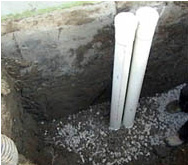Searching for a contractor or a licence number: consult the Licence holders' repertory.
Searching for a contractor or a licence number: consult the Licence holders' repertory.
Searching for a contractor or a licence number: consult the Licence holders' repertory.


It is possible to prevent iron ochre deposits, either before or after the construction.
One must keep vigilant when tell-tale signs appear such as the presence of reddish waters, after a rainfall, in ditches or on the ground surface.
During the construction of a property, it is recommended to enquire, with the neighbours and the municipality, about any history of iron ochre formations in the area.
A professional evaluation of the current conditions should also be made before proceeding with the construction. This evaluation should determine:
The results of this evaluation will enable the contractor to adapt his building strategy in order to avoid the effects of iron ochre formations.
Such adaptations may be as follows:
If the location of the construction site remains at risk, it is recommended to fit up two vertical cleaning conduits to enable the cleaning-up of the drain as needed.
Keep vigilant in the presence of tell-tales signs such as a high humidity level in the basement, a recent flood event, or the presence of reddish waters in ditches or on ground surfaces after a rainfall.
The possible remedial actions with existing buildings in order to alleviate the symptoms of iron ochre deposits will vary with the locations. Such actions may require:
Example of remedial action from the outside
Example of remedial action from the inside
For further information or to file a complain or report, visit the Contact the RBQ webpage.